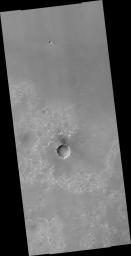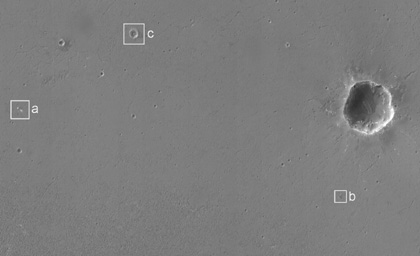
|
Mars Exploration Rover Landing Site at Meridiani Planum
- Click the image above for a larger view
- Full-Res JPEG (2048 x 3988) (641.2 kB)
- Full-Res TIFF (2048 x 3988) (8.2 MB)
Caption:

Click on image for larger annotated version
This HiRISE image shows the landing site of the Mars Exploration Rover Opportunity. The prominent impact crater on the right-hand side of the image is "Endurance crater" where Opportunity spent about ten months of its now nearly three-year mission. The bright irregularly-shaped feature in area "a" of the image is Opportunity's parachute, now lying on the martian surface. Near the parachute is the cone-shaped "backshell" that helped protect Opportunity's lander during its seven-month journey to Mars. Dark surface material may have been disturbed when the backshell touched down, exposing the lighter-toned materials seen next to the backshell. Area "b" of the image shows the impact point and the broken remnants of Opportunity's heat shield. The heat shield protected the vehicle during its fiery descent through the martian atmosphere, and then was released from the spacecraft during the final stages of the descent, breaking into two pieces when it hit the martian surface. Also visible is the small crater formed at the heat shield's impact point. Opportunity visited the heat shield during its drive southward from Endurance crater. Area "c" of the image shows "Eagle crater," the small martian impact crater where Opportunity's airbag-cushioned lander came to rest. The lander is still clearly visible on the floor of the crater. Opportunity spent about 60 martian days exploring rock outcrops and soils in Eagle crater before setting off to explore more of Meridiani Planum.
Image PSP_001414_1780 was taken by the High Resolution Imaging Science Experiment (HiRISE) camera onboard the Mars Reconnaissance Orbiter spacecraft on November 14, 2006. The complete image is centered at -2.0 degrees latitude, 354.5 degrees East longitude. The range to the target site was 278.1 km (173.8 miles). At this distance the image scale ranges from 27.8 cm/pixel (with 1 x 1 binning) to 55.6 cm/pixel (with 2 x 2 binning). The image shown here [below] has been map-projected to 25 cm/pixel and north is up. The image was taken at a local Mars time of 3:26 PM and the scene is illuminated from the west with a solar incidence angle of 54 degrees, thus the sun was about 36 degrees above the horizon. At a solar longitude of 135.3 degrees, the season on Mars is Northern Summer.
Background Info:
NASA's Jet Propulsion Laboratory, a division of the California Institute of Technology in Pasadena, manages the Mars Reconnaissance Orbiter for NASA's Science Mission Directorate, Washington. Lockheed Martin Space Systems, Denver, is the prime contractor for the project and built the spacecraft. The High Resolution Imaging Science Experiment is operated by the University of Arizona, Tucson, and the instrument was built by Ball Aerospace and Technology Corp., Boulder, Colo.
Cataloging Keywords:
| Name | Value | Additional Values |
|---|---|---|
| Target | Mars | |
| System | ||
| Target Type | Planet | |
| Mission | Mars Reconnaissance Orbiter (MRO) | Mars Exploration Rover (MER) |
| Instrument Host | Mars Reconnaissance Orbiter | Opportunity (MER-B) |
| Host Type | Orbiter | Rover |
| Instrument | High Resolution Imaging Science Experiment (HiRISE) | |
| Detector | ||
| Extra Keywords | Atmosphere, Crater, Grayscale, Impact, Map | |
| Acquisition Date | ||
| Release Date | 2006-11-29 | |
| Date in Caption | 2006-11-14 | |
| Image Credit | NASA/JPL/Univ. of Arizona | |
| Source | photojournal.jpl.nasa.gov/catalog/PIA09364 | |
| Identifier | PIA09364 | |
